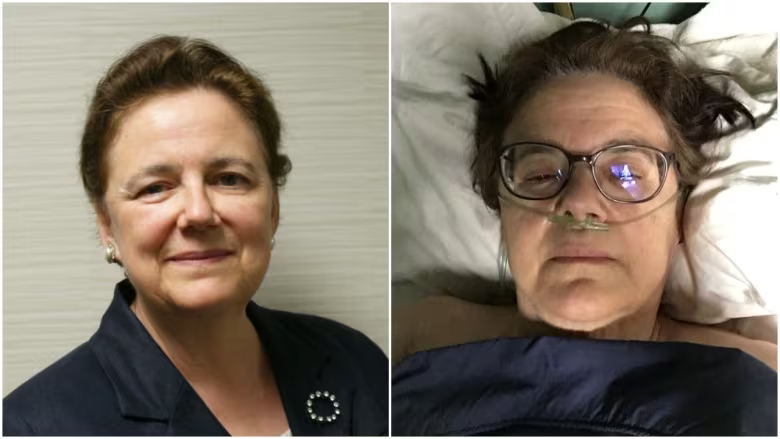Maryanne Andrew has been getting sicker and sicker since she caught COVID-19 in January 2022 while working in a Campbell River school.
And instead of helping, she says, WorkSafeBC’s attempts to require her to go back to work have made her symptoms worse.
Andrew is among more than two million Canadians still suffering from long-term COVID symptoms as of last summer, according to a Statistics Canada survey, which also found about half of the patients reported not seeing any improvements in their condition over time.
After two years of dealing with symptoms, Andrew was diagnosed with long COVID by a chronic disease specialist in January.
She says her long COVID symptoms got worse every time WorkSafeBC required her to go back to work, until she had to stop working.
Two years ago Andrew took two weeks off work as an educational assistant when she caught COVID. She tried to return to work, but after a short time she was too sick to continue.
“My body couldn’t handle it; it crashed me really hard,” said Andrew, whose symptoms include headaches, sensory and memory issues and post-exertional malaise. “I ended up in emergency, and that was the beginning of my journey.”
Andrew filed a claim with WorkSafeBC because she had acquired the illness at work. The agency assigned her an occupational therapist and repeatedly pushed her to return to work, she said.
“In the first 14 months, I did three gradual returns to work and my body was getting sicker and sicker,” Andrew said. “They made me work Monday, Wednesday and Friday, and [at first] my body would recover on the days in between.” But then “my body wasn’t recovering anymore and now I’m sick all the time.”
Andrew says WorkSafeBC now has access to reports from a chronic disease specialist and her insurer-assigned occupational therapist who attested to her long COVID symptoms and said she could not return to work.
But in a meeting with her school district, union and WorkSafeBC on March 1, Andrew says, she was told to try going back to work one more time before a decision on whether she can receive long-term disability payments.
“Technically they should just listen to the specialist and give me long-term disability,” Andrew said. “But I have to prove I’m sick... when I’ve already proved it three times.”
A misunderstood illness
Susie Goulding is founder of the COVID Long-Haulers Support Group Canada, an advocacy group for people dealing with long COVID. She says there are many people like Andrew whose symptoms are getting worse because doctors and insurance companies don’t understand the illness.
“They don’t understand that with long COVID, you can be fine one day doing whatever tasks have been set up for you to return to work, but then have to go outside of your allotment of energy, then end up crashing, coming back [to work], and not being able to do the same tasks,” said Goulding, who is a long COVID patient herself.
Goulding and Andrew said long COVID patients are sent for neurological assessments, occupational therapy or exercise, as part of return-to-work plans set by workers’ compensation boards across Canada, like WorkSafeBC.
“Our bodies can’t handle exercising, and I have post-exertional malaise, so that was crashing me, work was crashing me,” Andrew said. Post-exertional malaise brings the worsening of symptoms after even minor physical or mental exertion, often lasting for 12 hours or more.
Andrew said she considers herself lucky to have received any compensation for wages lost when she was too sick to work, and it happened because other employees from the school had also claimed benefits after catching COVID-19 at work around the same time. “They even put that on my paperwork and that’s why I got approved,” Andrew said.
Goulding shared half a dozen examples of long COVID patients from her support group — which has nearly 20,000 members — who had their WorkSafeBC claims rejected and had to hire a lawyer or spend years appealing the rejections to get compensation.
“So many more people who don’t get approved and give up, because when you’re advocating for your health, it can take a toll on your health and make matters worse,” Goulding said. “When you’re in the situation of being ill with long COVID, and you don’t have any financial income, it’s very difficult to find your way... to obtaining legal help.”
Most WorkSafeBC claims approved
According to the WorkSafeBC COVID-19 claims website, the agency had received 22,306 COVID-19 related claims and approved 17,819 in the 12 months up to January 2024, with the remaining 23 per cent being disallowed or suspended.
Andrew’s case falls in the "approved" category, because she received short-term benefits. But her claim for long-term disability remains unresolved.
In an emailed statement to The Tyee, WorkSafeBC said eligibility for benefits after contracting COVID-19 is determined on a case-by-case basis, based on workers’ diagnosis, symptoms, exposure history and whether their work placed them at a greater risk of exposure to the virus than the general public.
“COVID-19 claims are allowed when there is sufficient evidence to establish that the worker has COVID-19 and the risk of contracting the disease in their workplace was significantly higher than the risk to the public at large,” the spokesperson said.
When asked how long eligible workers receive benefits before WorkSafeBC requires further proof of their illness, the spokesperson said it depends “on the individual situation of each worker, and as such, the requirement for medical evidence is not tied to any specific time period.”
The agency said it needs more time to answer The Tyee’s questions of how many long COVID patients have appealed WorkSafeBC decisions that required them to return to work, or how many times the agency has sent long COVID patients to occupational rehab or exercise programs.

Goulding said patients face “layer after layer of barriers working against you to be able to get any kind of support.” Many in B.C. aren’t able to access a primary care doctor, let alone a chronic disease specialist trained to detect long COVID, she said.
Andrew, who has a family doctor, said it took six months to access a chronic disease specialist.
Lorraine Graves, co-chair of the patient advisory committee at Long COVID Web — a network of scientists, clinicians and patients — has had long COVID for four years and been in touch with many others who live with the chronic illness.
“What the insurers do not understand is... they’re not making people better by getting them to do a bit more everyday graduated exercise; [it] makes people with long COVID worse,” Graves said.
“People who work at WorkSafe and in long-term disability are not malevolent. They’re good people trying to do their best, but to try and do your best without accurate information puts you and your clients at a huge disadvantage. It ends up costing everybody more money in the end.”
Both Graves and Goulding said they know long COVID patients considering applying for medical assistance in dying because they cannot afford to live without support.
Andrew said that when she discussed her long COVID symptoms with a WorkSafeBC vocational rehabilitation staffer in January, they were dismissed or linked with past illnesses and symptoms like fatigue from menopause or a sore throat several years ago.
WorkSafeBC said in its statement that it refers patients to doctors with specialized training when workers need medical evaluations, including a post-acute COVID clinic staffed by “specialists in internal medicine, respirology, and cardiology” to help with long COVID claims. Andrew saw an occupational therapist through WorkSafeBC but said she was not referred to any specialized doctors through the agency.
“I’m the one who’s had to advocate, reach out and educate myself about this new disease and figure out what’s happening,” Andrew said. ![]()
Read more: Health, Rights + Justice, Coronavirus, Labour + Industry

















Tyee Commenting Guidelines
Comments that violate guidelines risk being deleted, and violations may result in a temporary or permanent user ban. Maintain the spirit of good conversation to stay in the discussion and be patient with moderators. Comments are reviewed regularly but not in real time.
Do:
Do not: